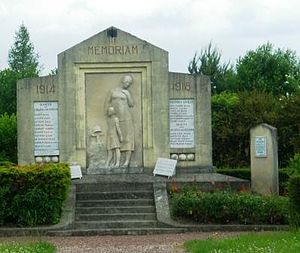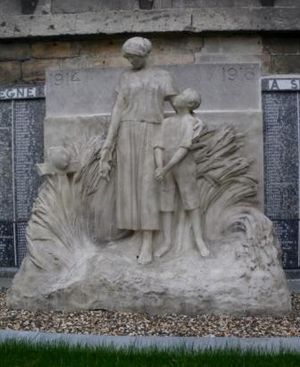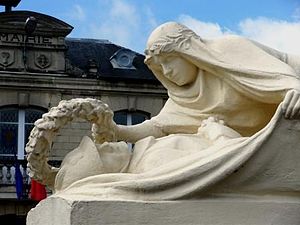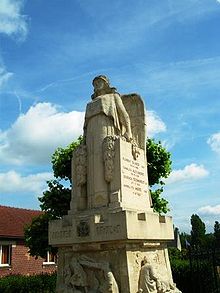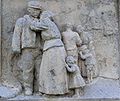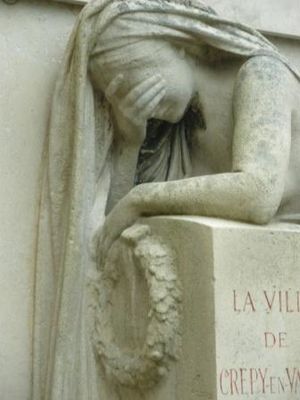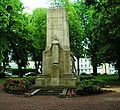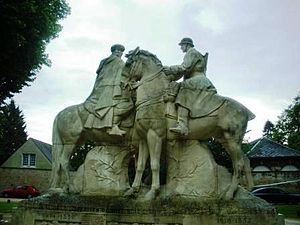- Monument aux morts (Oise)
-
There are well over 700 individual monument aux morts (war memorials) in Oise, in the region of Picardy, and this article describes some of them, with information on the sculptors, marbriers or foundries involved.
This continues the articles written on the monument aux morts of Picardy in the Western and Eastern areas of the Somme.
Background
The north eastern part of the Oise region was directly involved in the Great War and the Massif de Thiescourt saw brutal exchanges as this area, known as "Little Switzerland", lay directly in the way of the German army's route to Paris. From October 1914 to March 1917 the front had stabilised along a line passing through Lassigny, Tracy-le-Val and Bailly and during two years of occupation the German army lived in the towns and villages of the Noyon area, preparing offensive moves, organising their defences and the French army had the task of containing them.
In March 1917, in a tactical move, the Germans moved back to the Hindenburg Line but left much destruction in their wake and the areas which they vacated were then occupied by the allies. 1918 saw the German "Spring Offensive" with the German army retaking the area they had vacated and advancing even further and there were battles fought at Noyon and Mont Renaud in March and April 1918 and at Matz in June 1918. Further ferocious battles were then fought until August 1918 when Montdidier and the massif of Thiescourt were liberated. All of these efforts helped to stop the German advance on Paris and assisted the Allied success in the summer and autumn which saw the Germans pushed back to the Hindenburg Line and finally saw the Armistice being signed at Rethondes on 11 November 1918.
Apart from the usual trench based skirmishes, the area around the front line also suffered much damage from bombing ; artillery firing from both sides of the line caused much damage and loss of life and in addition the area suffered aerial bombing from Zeppelin airships and German aeroplanes. Villages directly on the front line suffered great devastation; Ribecourt, Tracy-le-Val, Bailly, Chiry-Ourscamp, and Dreslincourt were almost totally destroyed and Compiègne and Noyon suffered much damage. One German long-range gun in particular, stationed in the forest at Coucy-le-Chateau, caused great damage. The bombing reached as far as Beauvais where in June 1918, 36 soldiers and civilians were killed. Breteuil, Crèvecœur-le-Grand and Crépy-en-Valois were all hit by bombs.
Noyon
The monument aux morts in Noyon is shaped like an artillery shell and was designed by the Paris architects Eugene Chifflot and René Lefevre who had carried out several commissions of reconstruction in the Noyon area. The bas-reliefs on this monument are the work of Émile Pinchon.
The monument aux morts stands in the Place du Parvis. The door of the crypt, built into the centre of the monument, has an angel of victory carved on it together with the name Noyon surmounted by the Noyon coat of arms flanked by the Cross of the Légion d'honneur and the Croix de guerre.
Émile Pinchon
Émile Pinchon (1872–1933) was the younger brother of the famous French illustrator, Joseph Porphyre Pinchon (1871–1953), creator of the Bécassine character. Both brothers, though born in Amiens, lived for part of their lives in Noyon.
Pincon executed four fine bas-reliefs for the Noyon monument aux morts, these showing 1) The taking of hostages on 29 September 1914; 2) the re-entry of French troops of the 13th Corps on 18 March 1917; 3) The ruins of Noyon on 25 August 1918 and 4) the presentation to the town of the Légion d'honneur and Croix de guerre on 10 July 1920 by Maréchal Joffre. The Noyon monument aux morts was inaugurated on 22 March 1925.
Here are photographs of the four reliefs.
Pinchon also executed four bas-reliefs for the 1934 Paris Colonial exhibition and these can be seen in the Noyon town hall. They represent "travaux industriels dans les colonies" and were given as a gift to Noyon by Pinchon's widow. The subjects covered include rice harvesting in Indo-China, rubber plantations, and phosphate mining in Morocco. Pinchon also sculpted the statue of Joan of Arc in Nôtre Dame cathedral in Noyon called "La rehabilitation de Jeanne D’Arc". In the town hall there is also a painting by Joseph Porphyre Pinchon representing the presentation of the croix de guerre to Noyon - "Remise de la croix de guerre à la Ville de Noyon".[1]
One of Pinchon's other contributions to monument aux morts is to that at Bois-Colombes in the Hauts-de-Seine. This 1922 work comprised a poilu and child and a bas-relief entitled "Les horreurs de la guerre et les bienfaits de la paix".[2]. He also executed the sculptural work of an equestrian figure on the monument aux morts at Choisy-le-Roi in the Val-de-Marne.
Noyon has a fine Early Gothic cathedral which was restored after 1918. Noyon had suffered much destruction during the war. Noyon is where John Calvin, the leader of the Protestant Reformation in Geneva was born in 1509.
Appilly
The commune of Appilly lies to the east of Noyon and can be reached by the D1032. Marius-Léon Cladel (1883–1948) the sculptor, worked on this commune's monument aux morts, a composition which features a widow and her daughter standing before the grave of her husband. It is a fine work and reminiscent of the style of the English sculptor Gilbert Bayes. The monument dates from 1929 and the inauguration took place on 6 October 1929.
Marius-Léon Cladel
Marius-Léon Cladel was a sculptor and painter and had been a pupil of Antoine Bourdelle. He is well known for his statue "La Danseuse" at Vervins. Two bas-reliefs, upon which Cladel worked with Carlo Sarrabezolles, featured in the colonial section of the Africa Pavilion of the 1925 Paris exhibition. One featured a monkey and the other a whale.
Carlepont
The commune of Carlepont lies a few kilometres south from Noyon on the D145 and here the monument aux morts features a work by Joseph André (sculptor) (1886–1962) who was based in Noyon. Joseph André (sculptor) was responsible for several monument aux morts in the Oise region although born in Soignies in Belgium. The Carlepont monument dates from 1921 and the inauguration took place on 16 August 1921. André was also involved in the monuments aux morts of Grandru, Porquericourt and Ville.
Ribécourt-Dreslincourt
Ribécourt-Dreslincourt lies south of Noyon. There were in fact two villages which were merged in 1970 and thus two monument aux morts, one in each village. That at Ribécourt remembers the 26 men killed and features a sculpture of a poilu. It was inaugurated on 24 August 1924. The monument aux morts at Dreslincourt was erected three years later and is an obelisk surmounted by a croix de guerre. Both Ribécourt and Dreslincourt were badly damaged during the war and both churches, that of Saint Remi in Ribécourt and Saint Eloi in Dreslincourt, had to be rebuilt. Interesting to note that there were many underground caves in this area and these were used extensively by both German and French armies as living quarters/shelters.
Beauvais
Beauvais is the capital of the Oise region and has a magnificent cathedral, the Cathédrale St. Pierre. Its monument aux morts features work by Henri Gréber [1854-1941]. The Gréber family were well known in Beauvais, running a pottery known as Manufacture Gréber, and given the practice already mentioned, of trying where possible to give work to local artists, it is not surprising that Gréber was given the commission for the monument aux morts. The monument was inaugurated on 6 July 1924. The pottery mentioned has in fact been restored and is now the "Écomusée des Pays de L’Oise" and Gréber's bas-relief showing a worker at a potter's wheel can still be seen there. The building is at 63, rue de Calais. The ceramic work on the front of the building was carried out by Charles Gréber, a brother of Henri. [3]
Henri Gréber also carried out the sculptural work on the monument aux morts at Ardres in the Pas de Calais. Here the poilu portrayed shouts out in triumph:- Debout les morts ! le jour de gloire est arrivé !
Gréber was seemingly inspired by the mémoires of a lieutenant Péricard who wrote that during an attack on the Yser in 1914 he had imagined that he had seen dead soldiers rise up to give assistance.[4]
Auneuil
From Beauvais one can drive south to Auneuil by the D981 and here the monument aux morts features a Fonderie d'art du Val d'Osne edition, this by the Italian sculptor Pierre Lorenzi. Reference was made to Fonderie d'art du Val d'Osne in the article on the Eastern region of the Somme. The work features the bronze bust of a poilu and was number 503 in the Fonderie d'art du Val d'Osne catalogue. This work can be seen throughout France, sometimes with the French flag draped to the rear of the bust. The monument was inaugurated on 22 June 1920 and the total cost was 7,580 francs.
Neuilly-en-Thelle
Taking the D1001 south from Beauvais will take one to the village of Puiseux-le-Hauberger and from there the D92 reaches Neuilly-en-Thelle. In this village the monument aux morts features the "Soldat vainqueur" a piece marketed by the foundry Société Antoine Durenne and the work of the sculptor Léon Leyritz. The monument aux morts was inaugurated on 16 October 1921. Many Société Antoine Durenne pieces can be seen in the Oise region.
Formerie
In this commune for example, which lies northwest from Beauvais, the monument aux morts features a gallic cock which was one of the bronzes marketed by Société Antoine Durenne this dating from 1921. This work was entitled "Coq modele D" in the Société Antoine Durenne catalogue and appears on monument aux morts throughout France. There were two variations; The cock stood as in this case on a flat platform or in other instances on a globe. Unusually for Société Antoine Durenne the sculptor was not identified. The monument was inaugurated on 25 September 1921.
Compiègne
The Compiègne monument aux morts features a work by one of France's great sculptor's Maxime Real del Sarte (1888–1953). It was inaugurated on 11 November 1922 and the work was reputedly inspired by Jean-François Millet's painting "L’Angelus".
Maxime Real del Sarte
There are many great public works by Maxime Real del Sarte throughout France and one of the most famous is the pyramid type monument at the Ferme du Navarin in the Champagne region. Maxime Real del Sarte's composition features a group of three soldiers in attacking mode. It was said that the soldier in the centre was meant to represent a likeness of General Gouraud, that the soldier on the right was based on Quentin Roosevelt, the nephew of Theodore Roosevelt who was killed near Cambrai on 14 July 1918. The soldier on the left was said to be based on Maxime Real del Sarte's brother, killed in the Champagne during the war. Del Sarte himself was injured fighting in the Éparges section of the Verdun front on 29 January 1916 and part of his left arm had to be amputated.
Del Sarte was also the sculptor of the Laventie monument aux morts. In del Sarte's composition a woman who symbolises France holds a dead soldier in her arms. Behind them is a giant croix de guerre and at their feet a sheaf of corn.
Ressons-sur-Matz
From Compiègne one can drive in a north westerly direction along the D935 to reach the village of Ressons-sur-Matz and here see another monument aux morts featuring a work by Maxime Real del Sarte. The plaster model of this work, entitled "je t’ai cherché" was exhibited at the Salon des Artistes Française in 1920 and there are several examples of the work in monuments throughout France. It was said that the likeness of the soldier was based on Charles Eudes one of Maxime Real del Sarte's comrades at the front. Maxime Real Del Sarte was recommended as the sculptor for the Ressons-sur-Matz monument aux morts by the writer Binet-Valmer who had taken part in the liberation of the village in 1918. The monument aux morts at Ressons-sur-Matz was completed in 1924.
Marquéglise
From Ressons-sur-Matz the commune of Marquéglise lies just a few kilometres away and here is a remarkable monument aux morts with high-reliefs around the pedestal by Marcel Pierre de Bréal. These show various stages in the life and death of a soldier. At the top of the pedestal is an allegory of France topped by a helmet bound by laurel. "France" holds a crown of laurel in each hand. The work was executed in 1924. Sadly the high-reliefs are now very worn after so many years being exposed to the elements!
Below are photographs of the four high-reliefs.
Antheuil-Portes
Here can be seen one of Établissements Rombaux-Roland's editions, one that can be seen throughout France. This monument aux morts dates from 1925 and the inauguration took place on 17 May 1925.
Remy
This commune's monument aux morts features a Établissements Rombaux-Roland bronze. It dates from 1920 and the monument aux morts was inaugurated on 22 August 1920. This bronze gallic cock can be seen throughout France being one of Établissements Rombaux-Roland's most popular pieces. Sometimes the cock stood on a half - globe with laurels or on a full globe or as at Remy on a flat platform. As was usual with Établissements Rombaux-Roland the sculptor remains anonymous.
Crépy-en-Valois
Returning to Compiègne one can take the D332 going south to Crépy-en-Valois and this commune's monument aux morts features a work by Albert Bartholomé(1848–1928) who was the sculptor of the monument aux morts which stands in the Père Lachaise cemetery in Paris - probably the definitive monument aux morts. It was Albert Bartholomé who designed the croix de guerre. The Crépy-en-Valois monument features a woman weeping over the corpse of a dead soldier and was inaugurated on 11 November 1925. It was a replica of the statue commissioned in 1918 by Marie Henriette Bernard de Sassenay,the Baroness of Laumont, for the tomb of her son, Jacques Benoist de Laumont who had been killed in the Great War and was called "le soldat gisant" In June 1918 this composition featured in an exhibition held at the Petit-Palais in Paris by "la Sociètè des Artistes Française et de la Sociètè Nationale des Beaux-Arts" and was number 637 in the exhibition catalogue. Albert Bartholomé completed the Crépy-en-Valois sculpture for free in memory of his deceased wife who had been born in the nearby village of Bouillant.
Creil
The monument aux morts here involves a work by Georges Armand Verez (1877–1933). The monument was completed in 1925 and inaugurated on 17 October 1926. The cost of the monument was 75,000 francs. Criel organised a competition in 1923 to select its monument. The monument is meant to represent "Peace" and is as such grouped under those monument aux morts labelled as "pacifistes".
Georges Armand Verez
Verez lived in Paris but was born in Lille. He was the sculptor of the four large groups in the foyer of the Opéra de Lille and the sculpture "Le Pardon" which stands in the Place Vanhoenacker there. Elsewhere he was the sculptor of the monument aux morts at Ris-Orange near Paris, and the monument aux morts "France victorieuse" in Pau.[5]
Senlis
The monument aux morts at Senlis was the work of Gaston Dintrat (1889–1964). Gaston Dintrat was born in Valence, and studied at L'École des Beaux-Arts de Toulouse. He worked in the studios of Gaston Toussaint (1872–1946). Dintrat worked on several monument aux morts including those at Voiron, Joyeuse and Valence.The monument aux morts at Senlis was inaugurated by Monsieur Poincaré on 15 July 1923 and features two reliefs by Dintrat.[6] The monument also marks the furthest point reached by the Germans on 2 September 1914. Senlis is also the site of the monument aux morts created for Casablanca by Paul Landowski and moved to Senlis after Morocco received her independence. The monument shows a Moroccan Spahi on horseback taking the hand of a French cavalryman who faces him. Senlis had been briefly occupied by the German army at the end of August 1914 and the Germans had shot several hostages including the mayor, M. Odent. The town was awarded the croix de guerre at the end of the war. Senlis had been occupied by the Prussian army in September 1870. The Musèe des Spahis in Senlis covers the famous Spahis regiment's history.
Here are three photographs of the Senlis monument aux morts:-
Plus a study of the Spahis monument.
Saint-Samson-la-Poterie
At Saint-Samson-la-Poterie, which lies to the north west of Beauvais and can be reached by taking the D133 from Troissereux just north from Beauvais on the D901. The relief on the monument aux morts in this commune is by Louis Maubert (1875–1949). Maubert was born in Paris but lived at Bretigny-sur-Orge in Essone. This work was marketed by Établissements Hubert Coignet et Cie of Gennevilliers in Hauts-de-Seine. The relief is dated 1921 and the monument inaugurated on 9 October 1921. Cost was 4,500 francs excluding the foundations. The relief in question is one of a series and the model was made in 1916 when it first became obvious that a monument was going to be needed by each and every community. The organisation "Souvenir Français" put this forward to be considered as an "official" monument which it was hoped would be used by many if not all communities. This idea came to nought as the work was the victim of much criticism and the concept of a monopoly was unpopular. Amongst Maubert's other works are the monument commemorating Leon Chiris in Grasse, Alpes-Maritimes and a bas-relief on the tomb of Montaud Deluns in Clamart, Hauts-de-Seine but his best known work is undoubtedly the statue of Queen Victoria in Nice. Maubert was also the sculptor of the monument aux morts of Mazingarbe.Mazingarbe lies 4.8 kilometres northwest of Lens at the junction of the D176 and the D75. The monument aux morts stands near the church of Saint Rictrude and features a bronze bas-relief which shows a soldier embracing his old mother and shaking the hand of his father who is an ex-miner.
Grandvilliers
Sculptural work by Albert-Dominique Roze can be found in the Oise region and he was the sculptor used for the monument aux morts in Grandvilliers and Tricot. In Grandvilliers, the monument aux morts features a standing soldier (poilu), the work dating from 1920 and the inauguration took place on 11 November 1920. This particular Roze work can be seen at Allery, Quend and Valines in the Somme and also at Ribemont-sur-Ancre although in this case the rifle was held in the left hand and not the right. Grandvilliers can be reached by taking the D901 north from Beauvais.
Tricot
The monument aux morts at Tricot dates from 1922 although the inauguration did not take place until 5 October 1924. This figure of a poilu is identical to that at Bougainville in the Somme region. Tricot lies to the northwest of Compiègne on the D938.
Domeliers
The monument aux morts at Domeliers, which lies to the east of the A16 involves a bronze relief medallion by Léon Hernot (1894–1971) who was based in Lannion in Côtes d'Amour. It dates from 1923 and inauguration took place on 28 October 1923. This work can be seen on many monument aux morts in France albeit with slight variations; sometimes just the medallion is featured or it is superimposed on a vertical palm or is coupled with laurel branches. The foundry which cast the piece is not known. It was Yves Hernot senior (1829–1890) and Yves Hernot junior (1861–1929) who ran the Ateliers Yves Hernot sculpture workshop in Lannion in Brittany. The family specialised in calvaries and made some quite beautiful works; The "Breton Calvary" and the "Calvary of Protest" are two such works. After the Great War the Hernots produced a large number of war memorials and Yves junior's son, Léon, carved the monuments at Lannion and Plestin-les-Greves as well as Domeliers.[7]
Baron
The monument aux morts at Baron
At Baron is a monument aux morts dating from 1921 which was the work of Albert Jouanneault (1888–1944). The inauguration took place on 24 July 1921. Jouanneault was born in Saumur and studied sculpture in Paris under Jean Antoine Injalbert. He fought in the Great War and became a prisoner of war. He was the sculptor involved in many monument aux morts such as that at Stenay in the Meuse. He returned to Saumur during the Second World War and served in the resistance. He was taken prisoner and deported to Buchenwald where he died in 1944.[8] The monument aux morts at Baron features a standing soldier and the same statue appears in Le Puy-Nôtre-Dame in Maine et Loire. The monument cost 11,700 francs. In Saumur is Jouanneault's statue in memory of Dupetit-Thouars(1760–1798) and in L’Hay les Roses, in Val de Marne, there is a bust by Jouanneault of Jean Jaures.
Chantilly
At Chantilly is a monument aux morts which features a bronze work by Laurent Marqueste (1840–1920) who was born near Toulouse but lived in Paris. The Chantilly monument dates from 1922 and was inaugurated on 12 November 1922. The bronze is an allegory of "Victory" and the same work can be seen on the monument at Blamont in Meurthe-et-Moselle. Amongst Marqueste's many public works those in La Fleche in Sarthe are interesting. One is a bust of Léo Delibes and the other represents Lakmé a heroine of one of Delibes' operas. The original of the latter was melted down by the Germans in the Second World War and what can now be seen is a statuette given to the town in 1961 by a friend of the sculptor. This is held in the town hall.[9]
Verneuil-en-Halatte
Our final Oise region monument aux morts is that at Verneuil-en-Halatte an evocative work entitled "Le Coq gaulois écrasant l' aigle allemand "
Notes
- ^ http://www.noyon-tourisme.com/en/histoire_patrimoine/hotel_de_ville.html
- ^ http://www.culture.gouv.fr/public/mistral/palsri_fr?ACTION=CHERCHER&FIELD_1=REF&VALUE_1=IM92000219
- ^ http://www.culture.gouv.fr/picardie/les_services/definitions/archeo/plaquettes/Num19Beauvais2001.pdf
- ^ http://memoiresdepierre.pagesperso-orange.fr/alphabetnew/a/ardres.html
- ^ http://fr.wikipedia.org/wiki/Georges_Armand_V%C3%A9rez
- ^ http://fr.wikipedia.org/wiki/Gaston_Dintrat
- ^ http://www.infobretagne.com/hernot.htm
- ^ http://pagesperso-orange.fr/saumur-jadis/rues_a/albejoua.htm.
- ^ http://en.wikipedia.org/wiki/Laurent_Marqueste
References
- Patrimoine de France - Source of information on monument aux morts (French)
- FranceGenWeb - Source of information on monument aux morts (French)
- National Archives article on the Ferme de Navarin (See Maxime Real del Sarte above)
External links
- Sites of Memory (Historical markers, memorials, monuments, and cemeteries worldwide)
Categories:- French sculpture
- World War I memorials in France
Wikimedia Foundation. 2010.








